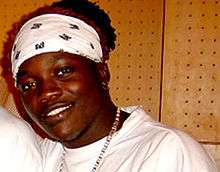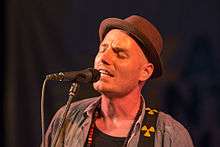Bongo Flava
| Bongo flava | |
|---|---|
| Stylistic origins | Hip hop, Tanzanian music |
| Cultural origins | 1990s Tanzania |
| Typical instruments | Bass guitar, drums, guitar, keyboards, percussion, vocals |
| Regional scenes | |
| Dar es Salaam | |
Bongo flava is the nickname for Tanzanian hip hop music. The genre developed in the 1990s, mainly as a derivative of American hip hop, with additional influences from reggae, R&B, afrobeat, dancehall, and traditional Tanzanian styles such as taarab and dansi, a combination that forms a unique style of music.[1] Lyrics are usually in Swahili or English.
The name "bongo flava" is a corruption of "bongo flavour", where "bongo" is the plural form of the Swahili word ubongo, meaning "brain", and is a common nickname used to refer to Dar es Salaam, the city where the genre originated. In the bongo flava, the metaphor of "brains" may additionally refer to the cunning and street smarts of the mselah (see below).[2]
The term "bongo flava" was coined and first mentioned in 1996 by Radio One's 99.6 FM (one of the first private radio stations in Tanzania) Radio Dj Mike Mhagama who was trying to differentiate between American R & B and hip hop music through his popular radio show known as 'DJ Show' with that of local youngsters music that didn't have, at that time, an identity of its own. DJ Show was the first radio show that accepted young Tanzanian musicians influenced by American music to express themselves through singing and rapping. He said on air, "After listening to "R & B Flava" titled 'No Diggity' from the United States,here comes "Bongo Flava" from Unique Sisters, one of our own." After he said that on the show, the term "Bongo Flava" stuck.
The earliest and most reliable account of how "Bongo flava" found its way onto Tanzanian airways has Taji Luindi at the heart of the story. Taji Liundi also known as Master T, the original creator and producer of the Dj Show program had already started airing songs by fledgling local artistes since late 1994. Mike Mhagama later joined the popular program as an under-study to Master T. He went on to produce and present the show alone after Master T had left Radio One in 1996. "Bongo flava" existed well before the first audio or video recordings. The youth in Dar es salaam were rapping at beach concerts(organized by Joseph Kusaga who owned Mawingu Discothèque, later Mawingu Studios and now Clouds Media Group), local concert halls and taking part in the first official rap competition called Yo!Rap Bonanza series that were promoted by DJ Kim "And the Boyz" Magomelo.
Some of the youth were organized with fancy names, some were solo or formed impromptu groups at the event to get a chance to grab the mic. An icon of the open performance artistes in the early 1990s was Adili or Nigga One. The first influential dub artiste of the genre was Saleh Jabir who rapped in Kiswahili over the instrumentals of Vanilla Ice's, "Ice Ice Baby", he was solely responsible for making Kiswahili a viable language to rap in. His version was so popular, it broke ranks by receiving mild airplay in the conservative National Radio Tanzania. The first official rap song to grace the Tanzanian airwaves.
One of the earliest groups to actually record and deliver a CD to Radio One for airing was Mawingu band, an outfit that became hugely popular in early 1994. They recorded at Mawingu Studios. Its members were Othman Njaidi, Eliudi Pemba, Columba Mwingira, Sindila Assey, Angela, Robert Chuwa, Boniface Kilosa (a.k.a. Dj Boni Love) and later Pamela who sang the famous hook of their breakout first RnB/Rap single "Oya Msela". The song was so popular and ahead of its time that the Msela label stuck. 'Msela' is the Swahili word for 'ruffian'. Mawingu Band was arguably the pioneer of the RnB flavored type of Bongo flava. Dar Young Mob were the first real hip-hop stylized group to record with Mawingu Studios under budding producer Dj Boni Love. They were the first group to have their rap single aired on private radio in Tanzania.
Popularity
Today, bongo flava is the most popular musical style amongst the Tanzanian youth,[3] something that is also reflected in the vast number of TV and radio programs dedicated to this genre as well as the sales figures of bongo flava albums.[4] Outside of its historical home of Tanzania, Bongo Flava has become a resoundingly popular sound in neighboring, culturally related countries such as Kenya[5] and Uganda. Bongo flava has even found a home outside of the African continent; the most popular artists in the genre have recently begun to address Western markets[1] and the self-proclaimed "best internet station for Bongo Flava,"[6] Bongo Radio, happens to be based out of Chicago, Illinois.
Despite the popularity of Bongo flava and the large number of well-known artistes throughout Tanzania, copying of music is widespread and most artistes are unable to make a living selling their music. They must alternatively rely on income from live performances to support themselves.[7]
Characteristics
While Bongo flava is clearly related to American hip hop, it is also clearly distinguished from its Western counterpart. As the bongoflava.net website puts it, "these guys don't need to copy their brothers in America, but have a sure clear sense of who they are and what sound it is they’re making". The sound "has its roots in the rap, R&B and hip hop coming from America but from the beginning these styles have been pulled apart and put back together with African hands".
The typical Bongo flava artiste identifies with the mselah. It is in this sense that, for example, members of the hip hop crew Afande Sele call themselves watu pori, i.e., "men of the savannah". A sort of manifesto of mselah ideology is given by the song Mselah Jela by Bongo flava singer Juma Nature, who defines the mselah, amongst other things, as an "honest person of sincere heart".[8] Following the tradition of western hip hop (as represented by the pioneering hip hop group Afrika Bambaataa), bongo flava lyrics usually tackle social and political issues such as poverty, political corruption, superstition, and HIV/AIDS, often with a more or less explicit educational intent, an approach that is sometimes referred to as "edutainment".[9] Afande Sele, for example, have written songs that are intended to teach prevention of malaria and HIV.
Notable artists
A pioneer of Tanzanian hip hop is Mr. II (also known as Sugu or 2-Proud), who released the first Bongo flava hit single, Ni Mimi in 1995. Mr. II is still active today (his last recording, Coming of Age, was released in 2007). The first Tanzanian hip hop crew, Kwanza Unit, began in 1993. They originally sung in English but eventually switched to Swahili. One of the former members of the group, Professor Jay, is currently one of Tanzania's most popular hip hop artistes.
Among today's most popular Bongo flava artistes are Ali Kiba, Juma Nature, Lady Jaydee, Mzungu Kichaa, Geezy Mabovu, Q Chillah, T.I.D., Diamond Platnumz and new artist of Bongo Flava like Nay wa Mitego, Ben Pol, Dogo Fani and many more. Some groups are very popular in their ethnic group; examples include the Maasai X Plastaz (who developed their own subgenre known as "Maasai hip hop").[10] Other popular names are Gangwe Mobb, Dully Sykes, and Daz Baba.
Gallery
-

Fid Q
-

Christian Bella
See also
References
- 1 2 Mueller, Gavin. "Bongoflava: The Primer." Stylus Magazine, 12 May 2005
- ↑ Stroeken, Koen (Winter 2005). "Immunizing Strategies: Hip-Hop and Critique in Tanzania". Africa. 75 (4): 488–509. doi:10.3366/afr.2005.75.4.488.
- ↑ (Italian) Article on Bongo Flava Archived April 9, 2011, at the Wayback Machine. at Antenne di Pace
- ↑ Quade, Birgit and Martin, Lydia. "Top of the Hip Hops Bongo Flava and more in Dar es Salaam, 2004." <"Archived copy". Archived from the original on 2008-03-17. Retrieved 2008-03-07.>
- ↑ Mueller, Gavin. "Bongoflava: The Primer." Stylus Magazine, 12 May 2005.
- ↑ "About Us." Bongo Radio. 2004. 6 March 2006. <"Archived copy". Archived from the original on 2007-10-12. Retrieved 2008-03-05.>
- ↑ Top of the Hip Hops: Bongo Flava and more in Dar es Salaam, 2004 Archived March 17, 2008, at the Wayback Machine.
- ↑ Mselah ni mtu safi, na ana moyo safi.
- ↑ Top of the Hip Hops: Bongo Flava and more in Dar es Salaam, 2004 Archived March 17, 2008, at the Wayback Machine.
- ↑ Bongo Flava: Swahili Rap from Tanzania

_at_the_2015_Zanzibar_International_Film_Festival.jpg)

.jpg)


